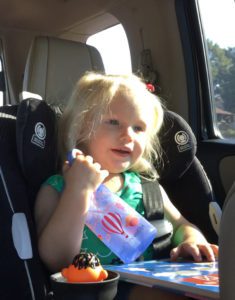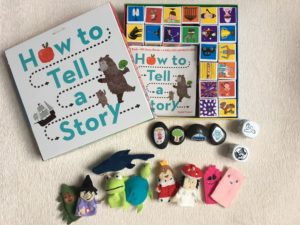Summer car trips can drag on for hours…sometimes days! Thanks to radio and mini-TVs we can entertain our children and easily pass the time away. Our family indulges in these luxuries, and are grateful for the relief they provide. But what if we turned them off and tried something else? What if you took your child to magical worlds and on daring adventures with nothing but your words?
Try storytelling!
My husband and I started telling stories on the car ride to Grandma’s house. The twenty minutes allowed ample time to make up multiple tales. (It also offered some relief from the overplayed car CDs. Sorry Raffi, Laurie Berkner, and Sesame Street) One day I turned the music off and said, “Honey, I’m going to tell you a story…” Ever since my first tall tale, about my daughter and her Ernie on an adventure, my children have begged us to tell stories in the car, at dinner, in the bathtub and at bedtime.

Tips for telling tales.
- Begin with your child as the main character. What makes storytelling between a parent and child so special is that stories can be personalized to include people, places, and things that are special to the child. These stories are compelling to young ones who are at a stage of development that is often egocentric.
- Where does your story happen? Choose a setting or an event. Our favorites include mishaps in the kitchen, one night while trick or treating, and running down the stairs to see…
- Add some drama. What makes your story exciting, surprising, funny or scary? You know what makes your child cringe, burst with excitement, or laugh. Use this knowledge! Also, do not forget to make sounds and silly voices.
- Wrap it up. Use your story to teach a lesson, empower your main character, or as a cautionary tale. Ours often include my daughters teaming up to solve a problem, thus reinforcing our desire to forge friendship and camaraderie between our girls.
Use story stones, storytelling games and finger puppets to inspire new ideas.

Why storytelling is important.
- “When adults and children share stories, whatever the child’s age, the benefits are many: relationships are strengthened, language is learned, literacy skills are introduced, new ideas are explored…feelings are communicated, and most important, the child and adult are having fun together.” Birckmayer, Kennedy and Stonehouse, From Lullabies to Literature.
- Also, research has shown that, “the more a child hears tales that include characters’ thoughts and feelings, the more keenly he or she understands the emotions of others,” Lev Grossman writes in an article for Real Simple magazine.
So try it out. Boost your child’s literacy skills and emotional intelligence by simply saying, “Do you want to hear a story?”
Read more from Birckmayer, Kennedy and Stonehouse in From Lullabies to Literature. Check out Lev Grossman’s ideas about storytelling. Create mini books of your most memorable stories using these simple instructions from Lauren Stringer.











I love this. And the time really does fly by when you are all wrapped up in a story!
Comments are closed.